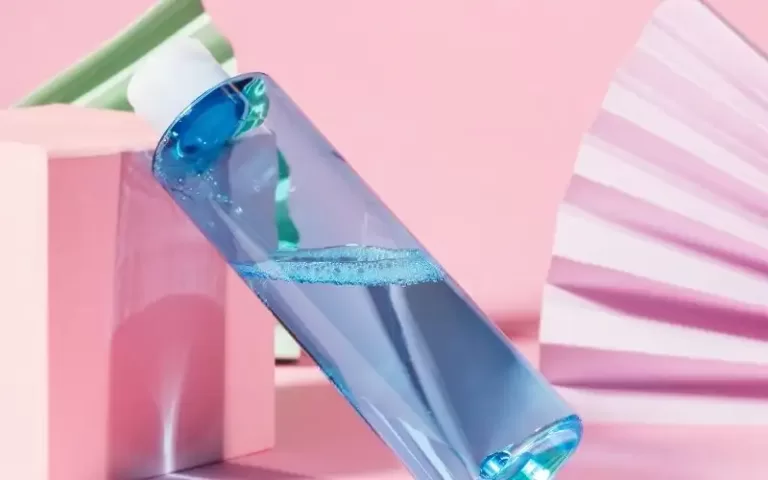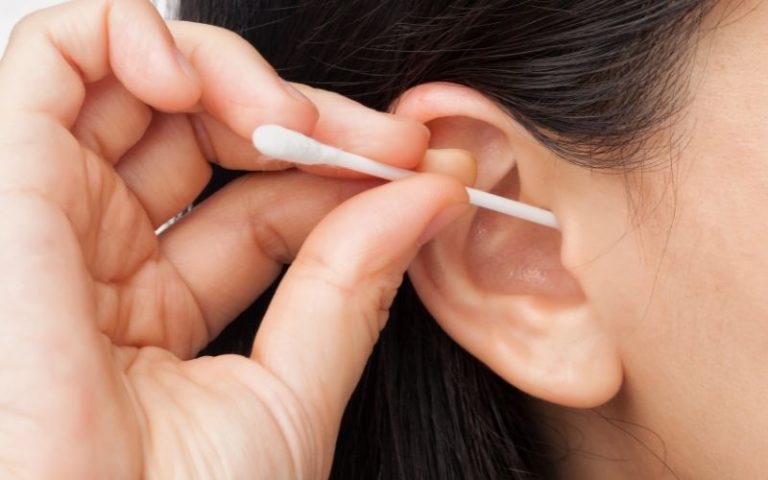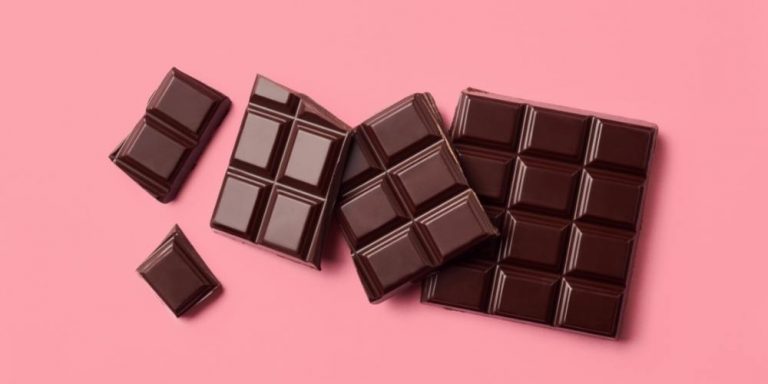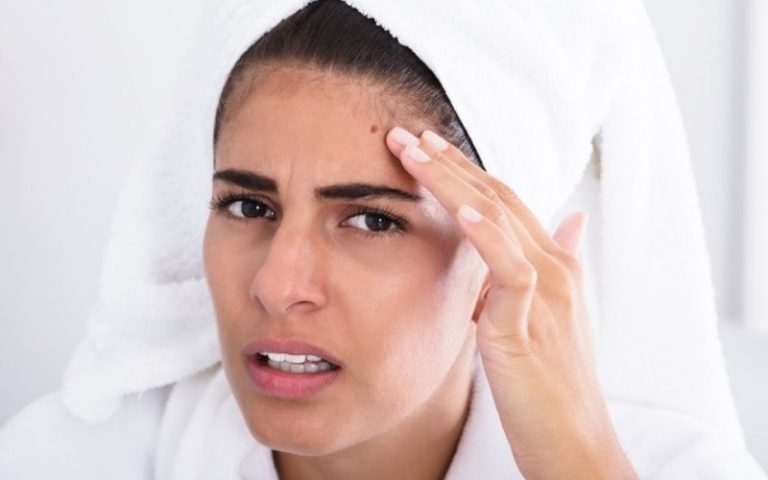Simple Body Acne Hacks That’ll Make You Rethink Everything
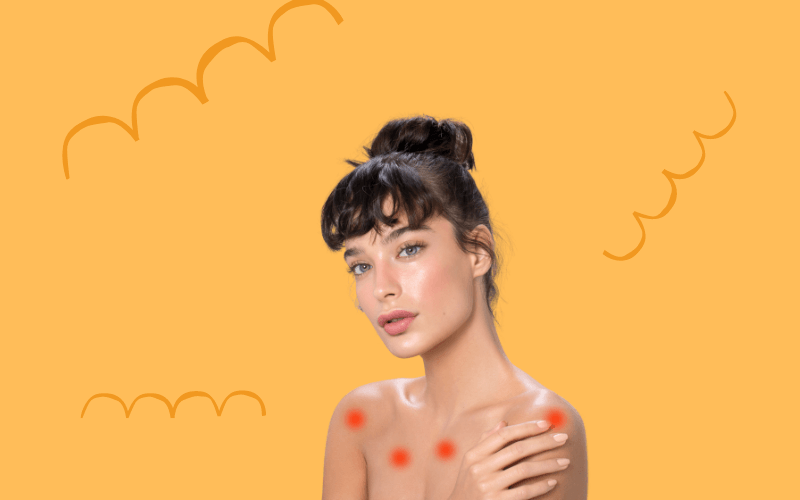
While we are constantly on the search for clear skin, just like the skin on our face, our body can experience acne too (sigh).
The good news is the skin on our bodies may be more resilient in comparison to our facial skin, especially with what we put it through.
There can be, however, a plethora of reasons why you are experiencing body acne.
Everyone’s skin is different, but there are a few common triggers that are worth looking into.
The philosophies that are used to treat pimples are universal.
As much as knowing your skin type is valuable, what really matters is addressing your skin concerns. Finding out the root cause is the best way to treat it.
The topic of acne is a common and universal concern, but finding what works for you may look different than someone else’s skin journey!
Without further ado, let’s talk body acne.
Types of body acne
Acne comes in many forms. What are the different kinds?
- Bumps, congestion/texture: Bumps and texture may be due to congestion that feels rough to the touch.
- Open comedones: Open comedones are when the hair follicles have a buildup of dead skin cells, forming a blackhead.
- Closed comedones: Closed comedones are when hair follicles are clogged up by a buildup of dead skin cells, where the follicle is covered with skin, forming a whitehead. It is important to note that the follicle in question is more commonly referred to as a pore.
- Papules/pustules: Inflamed, red, and painful pimples are present in the form of papules or pustules. This may have a yellow tint on top of it or have pus in it.
- Cysts/nodules: Cysts and nodules where the zit in question may be irritated or infected may feel like a thick bump under the skin characterized by a lot of redness.
It is also possible that you are experiencing acne-like symptoms, where it’s better to be diagnosed by a professional because it may be conditions such as keratosis pilaris, scabies, poison ivy, or folliculitis.
Similarly, acne-causing bacteria, like propionibacterium acne, would also be better suited for a derm to diagnose.
These are normally the spots that leave a noticeable scar after they have gone down.
Body pimple locations
It’s possible to find them in many areas, most commonly, the chest, back, shoulders/arms, buttocks, and the groin area.
The acne found on your back is more commonly referred to bacne, usually characterized by inflamed blemishes that are likely to be painful, swollen, and sensitive.
Back acne (or bacne) and chest acne usually go hand in hand.
All of these areas, however, undergo many stressors that can lead to the blockage of pores, irritation, friction, and exposure to triggers.
Ultimately, wherever you have pores, it is possible to experience acne.
Why do I have body acne?
Acne is also referred to as Acne vulgaris and can happen to people of all ages.
It is more common amongst teens undergoing puberty, but adult acne is also a common experience.
It’s when a follicle is clogged by dead skin, debris, and/or sebum.
Your sebaceous glands, the part of the follicle that produces oil or sebum, are the glands that may become overactive.
Genetics largely contributes to the likelihood of acne development.
Looking into your family history is a great indication of how likely you will experience it and to what degree.
Other factors include oil production, dead skin buildup, hormones, and sensitivities/allergies.
In terms of body acne, it can be due to improper exfoliation, experiencing a lot of dry skin or oily skin from a compromised skin barrier, overactive oil glands, wearing tight clothes, going through a stressful time, dealing with pregnancy or menopause, etc.
Acne is not, however, a one time deal. Ugh. It is (unfortunately) something that must be maintained for clear skin.
Hormonal imbalance
Please hormones, we beg you…chill out.
Hormonal acne is an aggravated condition due to increased inflammation, the activity of oil glands, and acne-causing bacteria.
Medication can be prescribed based on the cause of the hormonal changes.
It is present in teens as they go through puberty when hormones are trying to find their balance.
It is also a common experience during menstruation, menopause and pregnancy.
There are oral contraceptives to regulate your menstrual cycle like the birth control pill, such as ortho tri-cyclen, but there are possible side effects that are best discussed with your doctor.
Pregnant women, on the other hand, may have limited options as they cannot use topical retinoids and oral medication.
Having a hormonal disorder, like polycystic ovarian syndrome, can play a role in your complexion as well, not only through acne but also hair growth.
Another factor that contributes to hormonal changes is stress.
It can cause an imbalance in the androgen, estrogen, and testosterone hormones, which can lead to more flare-ups.
Hormonal breakouts can manifest in many ways and creating lifestyle changes, such as taking prescription oral medications, can improve the severity of the blemishes.
Prevention and treatments
Let’s talk about prevention. Treatments are cool too, but keepin’ it away is just as important:
Properly cleansing our skin
Here’s some general guidelines to follow to make sure your skin stays squeaky clean:
- Having the right ingredients on deck and being gentle is the best way to ensure the surface of your skin is prepped for the next step!
- Making sure to shower/rinse off after working out or after a long day are simple yet effective ways to get rid of excess sweat lingering behind.
- I know how much we all love our showers to be lava-level temperatures, but the temperature of the water is (very) important. Having warm water, that is not too hot nor too cold, helps with the hydration levels of our skin, and avoids further inflammation.
- Reaching for a mild soap that is not only hydrating but also non-stripping, will help calm any irritation and soothe the skin. Being thorough in the cleansing process is an effective preventative measure when trying to keep pores clean.
- Lastly, making sure all of your hair products, like your conditioner, is fully removed from your skin as a simple step in addressing bacne, chest acne, neck acne, and acne found on your forehead.
Even while working out, making sure to wipe sweat, oil, and buildup of a product can go a long way.
Limit touching your face and your body while also dealing with active spots by making sure to clean down sports equipment, washing your hands, tying your hair up, and keeping those hands off your skin.
Keeping your skin, where you have any lesions, clear of any possibilities of infection will limit the spread to other areas of the body.
The tools you use as part of the cleansing process are just as important as the ingredients you use.
It is also nice to introduce some tools for cleansing like a loofah, which should be replaced monthly to avoid microbe buildup.
The same goes for the towel that you use to dry down with, they must be cleaned regularly.
Your clothes have an effect
Wearing breathable fabrics and lighter clothes should help limit the amount of friction your skin undergoes.
Wearing tight clothes, like workout attire, where the skin is constantly rubbing against the sweaty clothes can cause irritation.
Not to say you can’t still wear your favorite joggers and tank tops but hey, give it some consideration.
This friction can exacerbate existing acne and increase the risk of more flare-ups in the form of acne mechanica.
Continuous friction will contribute to the redness and possibly dryness (with the increased physical exfoliation), further disrupting the skin barrier.
This is the same when talking about acne from wearing a mask.
Wearing freshly laundered attire every time you work out keeps the reintroduction of infection and bacteria at bay, especially if you experience inflammatory acne.
The same goes for having clean pillowcases and bedsheets.
Wearing softer fabrics that won’t further irritate your skin will also decrease the risk of rubbing on acne lesions that can spread infection and introduce swelling.
If you are experiencing active breakouts, softer and looser fabrics should lessen the discomfort.
How to formulate a body care routine
It’s not rocket science, we promise.
Skincare products, ingredients, and formulation play a huge role in acne treatments.
This applies to whether you are dealing with facial acne or body acne.
There are three main basic steps in treating acne:
- Cleansing
- Moisturizing
- Protecting
For most days you want to use a gentle cleanser, a moisturizer, and a sunscreen with SPF over 30.
As much as active products are important, having gentle, hydrating, and moisturizing products are just as valuable and a great place to start.
Regardless of the kind of acne you deal with, being gentle, patient, and consistent will give you better and sustained results.
Using the wrong products such as ones with high percentages of benzoyl peroxide or chemical exfoliants may end up being too harsh, leading to more acne breakouts.
Keep your skin barrier in mind
Replenishing your skin’s barrier will help balance excess oil, oil production, hydration levels, and dead skin cells buildup.
A fortified skin barrier makes the skin more resilient to environmental stressors and allows your skin to bounce back from stronger treatments.
This aids the healing process of acne, leading to healthier skin.
This also comes to play when dealing with large cysts, nodules, and more severe acne that leave behind acne scars and hyperpigmentation/discoloration.
Trauma to the skin, like acne, can leave behind scars that take a while to heal.
If you deal with a lot of inflamed blemishes, pus-filled zits, redness, etc. it’s worthwhile to look into the products you use right now.
If you have sensitive skin…
It’s possible you may have sensitive skin, which indicates it may be better to reach for products that don’t have strong fragrances and essential oils, such as tea tree oil.
It is very possible to develop a sensitivity to strongly fragranced products, whether in your hair care products, body wash, gel, lotion, or body spray/perfume.
A rash can be an indication of a possible sensitivity or allergic reaction, which is why it is always better to patch test any new products before using them.
Pick an area of the body to test the product for at least a week and monitor closely.
Cosmetics normally have fragrance added to them as well, but looking for skincare that is formulated without it is a great starting point to see what you are sensitive to.
If you have experience with other skin conditions like eczema, psoriasis, and rosacea, it may be all the more beneficial to stray away from strongly scented skincare.
Utilizing antioxidants to address inflammation, like green tea and Centella Asiatica can also help with calming the skin, especially in the case of more severe acne.
How to know if your routine is working?
Knowing to recognize when a product is working can be tricky.
The amount of time it takes the skin to go through its cycle is between 14-28 days and grows longer the older we age.
Give your products at least the amount of time it takes to go through a minimum of one cycle.
It is a great starting point to see if your routine is working.
However, discontinue a product if you see an immediate reaction from it (within the first few days). This is definitely a sign it’s not working for you and you should probably try something different.
Can diet affect body acne?
Having a healthy and balanced diet can’t hurt in treating acne-prone skin.
Having a balanced lifestyle, a nutritious diet, effective workouts, and proper water intake can all help with treating your concerns.
It is still possible, however, to still experience body acne, even after checking all of those boxes.
Being aware of the sensitivities you may have to food can help with the irritation and flare-ups.
Limiting the foods that trigger a reaction could make a significant impact if that was the cause of your body breakouts.
Try keeping your diet consistent and tracking the food that you put into your body.
Start by eliminating dairy, greasy, and processed foods first, then replace them with fruits and vegetables to see if you notice any improvements in your skin health.
Taking supplements regularly may help, but there is not much research suggesting how effective it is for achieving clearer skin.
Try exfoliating
Ex-fo-li-ate. You should try it, dude.
One of the biggest treatments of acne comes in the form of exfoliation. Exfoliation is the process of sloughing off dead skin cells.
There are two ways this is achieved:
Physical exfoliation
You can physically exfoliate with the use of scrubs and tools to remove the dead skin.
Chemical exfoliation
You can also chemically exfoliate with the use of alpha-hydroxy acids (AHA), beta hydroxy acids (BHA), and enzymes.
There are stronger chemical exfoliants formulated in the form of chemical peels to treat severe acne, pigmentation, and acne lesions.
These ingredients can also be formulated in spot treatments that can be left on overnight.
Look for products that are deemed non-comedogenic, which are less likely to clog the pores, can also help facilitate the shedding of skin cells properly.
You can find skincare products that contain active ingredients found over-the-counter (otc).
Effective acne-fighting ingredients to look out for
If you are dealing with inflammatory acne and a lot of redness, reaching for beta hydroxy acids (BHA), such as salicylic acid, and benzoyl peroxide are trusted anti-inflammatories options.
They are considered classic acne treatments for those dealing with excess oil production and acne-causing bacteria and can be commonly found in salicylic acid washes.
If you are dealing with bumpiness and texture, alpha hydroxy acids (AHA) such as glycolic acid, lactic acid, and mandelic acid could help with decongesting mild acne.
They chemically exfoliate the top of the skin, revealing newer skin, which makes it great for blackheads and whiteheads.
Skincare products that contain chemical exfoliants help to prevent future breakouts.
How often should I do this?
It is best to balance a routine that contains active products with a more gentle hydrating routine most days and an active one 2-3 times a week.
Actives can be formulated in a toner (like an astringent), cleanser, wash, or in a lotion.
Exfoliation is typically an effective preventive measure to help with breakouts.
Alternatives to exfoliation
Other options can be skincare products formulated with azelaic acid, sulfur, and retinol.
Retinoids may not be an exfoliating treatment, however, it does help with the regeneration of skin cells.
They can be applied like a topical gel in the form of adapalene (like in Differin) and tretinoin or taken orally like in the form of Accutane and isotretinoin.
Sunscreen, man.
Sunscreen is CRAZY important. Don’t overlook it.
Some of these acne-fighting ingredients can cause increased sensitivity to UV rays, which not only affects concerns like skin cancer, but also deep wrinkles and collagen.
When using a strong treatment like a peel or chemical exfoliator, it’s essential for the skin to be properly protected with adequate sunscreen use.
Look for non-comedogenic sunscreen (so your pores don’t get clogged) and an SPF of at least 30 to be sure your skin is getting protected from those savage UV rays.
See a dermatologist
Making an appointment with a pro will help you diagnose what exactly your body is going through.
They will be able to provide proper tests, identify the cause of acne, and prescribe medicine that may be more targeted and effective than over the counter products.
They are also the ones to prescribe higher doses of retinoids.
Dermatologists would be able to prescribe antibiotics in case you are dealing with an infection.
If a prescription is not necessary, they may advise looking into laser treatments and chemical peels as alternative options.
A few treatments that a dermatologist can prescribe:
- Isotretinoin/Accutane
- Erythromycin
- Doxycycline
- Tetracycline
- Tazarotene
- Tazorac
If after trying a few different otc products and lifestyle changes, but you still don’t see an improvement in your condition, it might be safer to get someone who studies skin in dermatology, to examine it.
In severe cases, it’s better to seek a derm to be safe instead of going through trial and error and possibly risk causing more harm.
Summary
Body acne can be caused by many triggers but there are lots of solutions that can help treat the issue and alleviate the discomfort.
There aren’t many treatments that can guarantee you permanent results, but many of them can treat the condition through a consistent routine.
From dealing with mild to moderate acne and possibly severe cases, there is relief in knowing that it can be maintained with proper cleansing, treatment, and protection.
There is a treatment plan that can be readily accessible to you!
No matter what type of acne you are dealing with, remember to be patient, gentle, and using everything in moderation when it comes to using different active products!
Surely, adding some of these tips to your skincare routine will show that body acne who’s boss.
References:
Amato, L., Bickmore, H., Doyle, J., Nielsen, M., Sarfati, L., Schlaiss, J., & Todd, L. (2019). Milady Standard Esthetics: Fundamentals (12th ed.). Boston, MA: Cengage.
